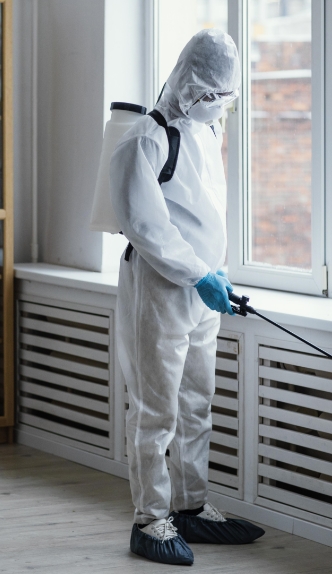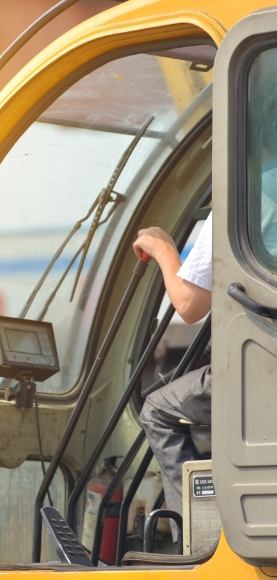Sources of Asbestos Exposure / Household Exposure to Asbestos
Household Exposure to Asbestos
If you shared a household or other space with someone who was regularly exposed to asbestos at work, you also may have been exposed to asbestos.
Asbestos fibers are tiny, durable, and can cling to work clothes and tools.
Nowadays, people cleaning asbestos are required to wear special protective masks and clothing to prevent them from inhaling or swallowing harmful asbestos fibers.
But for decades, the asbestos industry hid the dangers of its product. Many people regularly breathed in asbestos without knowing it could cause health problems later in life.
Many people do not know they were exposed to asbestos in the home.
Asbestos was widely used in industry, buildings and products for its durability.
Asbestos is resistant to heat, electricity and corrosion. Asbestos fibers do not evaporate or dissolve.
But asbestos can be easily broken up into fibers or powder and woven, sprayed or mixed with other building materials to strengthen and fireproof them.
Many work sites regularly exposed workers to asbestos inhalation, including many employees whose jobs did not directly involve asbestos.
People who shared a household with workers exposed to asbestos are also at risk.
- Asbestos is a very dusty mineral that sticks to clothes and other surfaces.
- Asbestos fibers can be microscopic, difficult to find, and hard to remove.
- Asbestos has no smell or taste. Asbestos fibers are easily inhaled and swallowed.


Many workers brought home asbestos on their work clothes.
Many people with asbestos-related illnesses were exposed by regularly cleaning their spouses’ asbestos-covered uniforms, work clothes, bags and tools.
Many laundry areas in older homes were often in small spaces.
Asbestos fibers are tiny and easily inhaled. Anyone dusting or touching clothes with asbestos may have breathed or swallowed harmful, microscopic fibers.
And even after cleaning, asbestos dust can stick to walls and floors. The residue can expose others who spend time in those areas.


Vehicles may have exposed motorists and passengers to asbestos, too.
Asbestos was used in many automobile parts, like brakes and gaskets.
Working on an older vehicle in a garage may have exposed the mechanic and others in the garage to asbestos fibers.
Asbestos is durable and a person driving with work clothes or tools may have contaminated the inside of their vehicle with asbestos dust.
Spouses, children and other passengers who regularly rode in those vehicles may have been breathing in harmful asbestos.
Anyone who shared a household with an asbestos worker may want to speak with a medical professional about early-detection of asbestos-related illnesses. |
Workers often brought asbestos from their job site into the home.
For decades, asbestos was used throughout most industries because of its durability and resistant properties.
Many people who did not work directly with asbestos were exposed in the buildings or other sites where they worked.
Asbestos exposure was found in:
Construction
Many people involved in construction and demolition were also exposed to asbestos products.
This money was specifically placed in a fund by courts to be given to people with asbestos-related illnesses.
And if you know you have asbestosis, pleural plaque, mesothelioma or cancer of the lungs, throat or colon, your condition may have been caused or aggravated by your exposure to asbestos, even if it was forty or fifty years ago.


Factories
Asbestos was used to strengthen, insulate, and fireproof factories of all kinds. Workers whose tasks were with or near high heat or friction were often exposed to asbestos. Many also may have made or worked with products containing asbestos.


This includes workers engaged in:
- Factories
Asbestos was used to strengthen, insulate and fireproof manufacturing buildings of all kinds. Workers whose tasks were with or near high heat or friction were often exposed to asbestos. Many also may have made or worked with products containing asbestos. - Foundries
Asbestos was used in foundries to insulate the intense heat generated. - Refineries
Asbestos is resistant to corrosion, and it was often contained in buildings and machinery used to refine chemicals. - Shipyards
Asbestos was used throughout ships to fireproof and insulate them. Seamen and offshore workers who spent time on or around vessels were often exposed to asbestos.
Vehicles
Asbestos was used in all types of vehicles, including:
- Cars
- Trucks
- Trains
- Motorcycle
- Buses
- Military
Asbestos was used in the manufacture of many automobile parts, especially those which were exposed to heat. This includes clutches, brakes, gaskets, insulation, hood liners, and auto-body parts.
Because asbestos was used in brakes and brake linings, the heat and pressure of automobile braking can release harmful asbestos dust into the air. People who work on cars or are regularly exposed to automobile exhaust may have inhaled asbestos dust.
Worker are at risk of exposure to asbestos if they were employed in:
- Vehicle Assembly
- Vehicle Repair
- Truck Stops
- Transportation
- Automotive Supply
- Toll Booth / Drive-Thru


Asbestos Products
Thousands of industrial and household products were manufactured with asbestos.
Asbestos was mixed with construction materials because of its strong resistant properties:
- Plaster
- Vinyl
- Insulation
- Drywall
- Tile
- Sealants
- Cement
- Paint
- Ducts
- Pipes
- Shingles
- Panels
In addition, consumer goods like ironing boards and textiles were made with asbestos.
Hair dryers made with asbestos can blow fibers into someone’s face and present a risk of cancer.2
Learn more about asbestos exposure from products containing asbestos.
Financial Compensation for People Injured By Asbestos Exposure
Millions of workers and their families were exposed to asbestos because the asbestos industry hid the dangers of its product.
Courts ordered that billions of insurance dollars be placed in trusts to compensate people with asbestos-related illnesses.
But nearly 40% of the funds have still gone unclaimed by the people they are intended to help. |
Justinian C. Lane, Esq.
My grandfather was exposed to asbestos aboard World War II Navy ships, and later on, as a mechanic. My grandmother was exposed washing his work clothes, and in her soldering job at an electronics factory assembly line. Both of them died of lung cancer.
In the years before he had me, my father worked at a titanium foundry, at a time when asbestos was still widely used to insulate against heat.
I never had an opportunity to see if any of them were exposed, but my father, grandfather and grandmother all died of cancers that can be associated with asbetos.
Don’t wait to find out if you were exposed to asbestos. You may be at risk of health problems, and have an opportunity to obtain early treatment.
And if you are already experiencing symptoms of an asbestos-related illness, find out if you may be eligible for compensation that can help reduce your financial strain and provide support and a legacy for your family.
Asbestos can take decades to cause illness like mesothelioma and lung cancer.
At AsbestosClaims.Law, we’ve helped thousands of people who were exposed to asbestos in their job, car or at home. Can we help you? |
1 An Evaluation of Reported No-Effect Chrysotile Asbestos Exposures for Lung Cancer and Mesothelioma, Jennifer S. Pierce, Meg A. McKinley, Dennis J. Paustenbach & Brent L. Finley, Critical Views In Toxicology (2008).
2 https://www.researchgate.net/profile/Peter-Preuss-3/publication/226179097_CRITIQUE-Consumer_product_safety_Risk_assessment_of_exposure_to_asbestos_emissions_from_hand-held_hair_dryers/links/5761627a08ae2b8d20ed576b/CRITIQUE-Consumer-product-safety-Risk-assessment-of-exposure-to-asbestos-emissions-from-hand-held-hair-dryers.pdf



